East of the mountains: gong
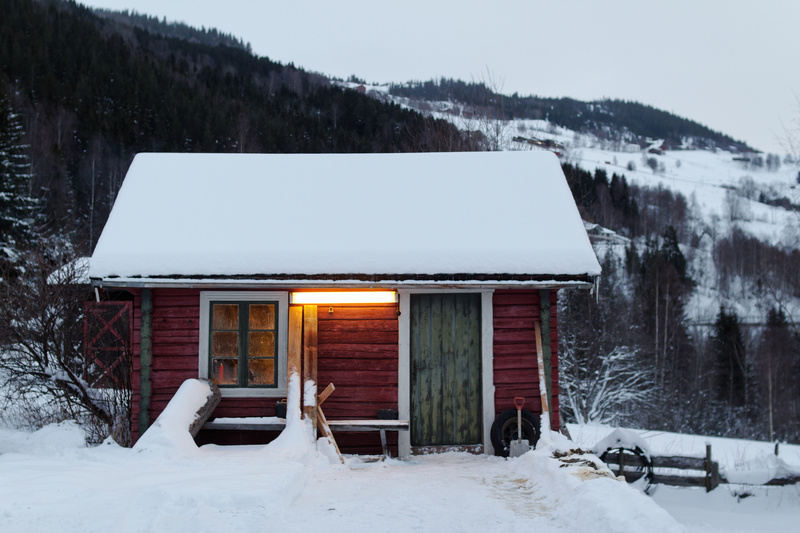
Sverre Skrindo's brewhouse in Ål |
I got the tip-off from Jørund Geving, a farmhouse brewer in Stjørdal. He'd gotten into a random conversation with a farmer from Ål in Hallingdal, who said there were people there who still brewed. That's in eastern Norway, so that was remarkable news in itself: a new brewing region! But then he dropped the real bombshell: these guys had their own yeast, which they called gong.
This was really exciting, because so far, every brewer in western Norway who has his own yeast has turned out to have yeast that belongs to a single family, which we call kveik. That makes me think that historically all farmhouse brewers in western Norway used kveik, but there is a massive mountain barrier between the west and the east in this country, so in the east people might well have had a different kind of yeast. Or not.
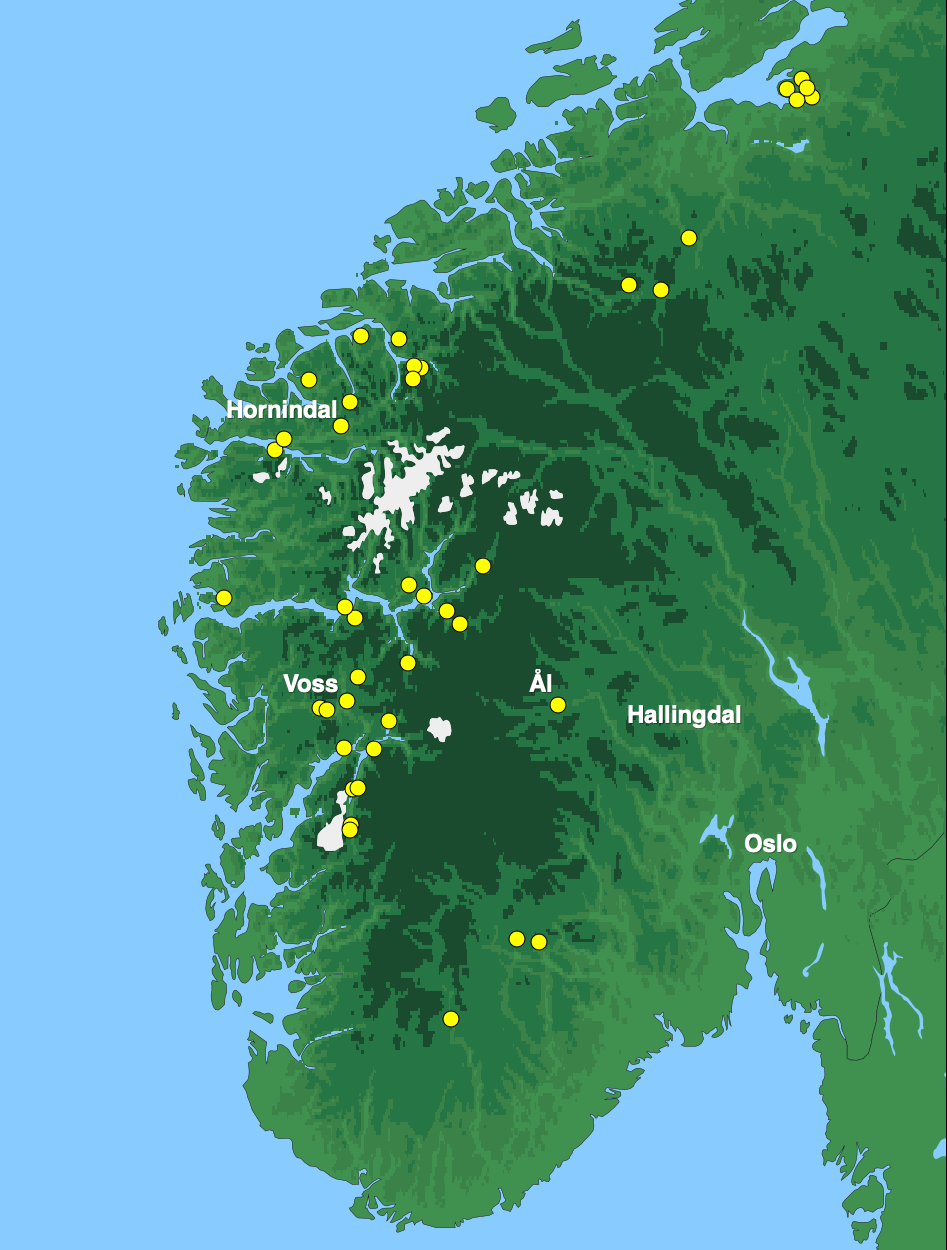
Ål on the map, with darker colours indicating higher elevations, and the glaciers shown in white. The pale bendy shape is the valley of Hallingdal, where Ål is. Yellow dots show places with active farmhouse brewing. |
I'd interviewed the local brewers over the phone, and eventually managed to invite myself to come visit Sverre Skrindo to see him brew his Christmas beer. Ål is a three-hour drive for me, and Sverre starts brewing early in the morning, so Sverre let me stay in the guest house on his farm, and I drove up the evening before.
It turns out Sverre actually begins not in the morning, but the evening before. So we trudged over to the brewhouse in the snow, and Sverre brought out the malts. I asked how much he uses, and he smiled. "Well," he said, "I use 6 settung. But I'm not sure how much that is in kilos, because this is a settung." He held up a wooden container held together by metal bands. That container is literally his definition of how much a "settung" is.

Sverre showing how much one "settung" is. |
Eventually, we determined that a settung is roughly 9 liters, so Sverre uses roughly 31 kilos of malt for 50 liters of beer. It's a pretty strong beer, in other words.
The next surprise was that Sverre poured all the malts into the kettle. It turned out that in the morning he was going to mash in the kettle, but for now he only poured cold water on the malts. He then took the mash paddle and worked the cold water into the malts. The mix was relatively dry, and once Sverre was finished with the paddle, it was going to be left over night.
So why did Sverre do this? Because that's what his father did. Why did his father do it? Sverre doesn't know.
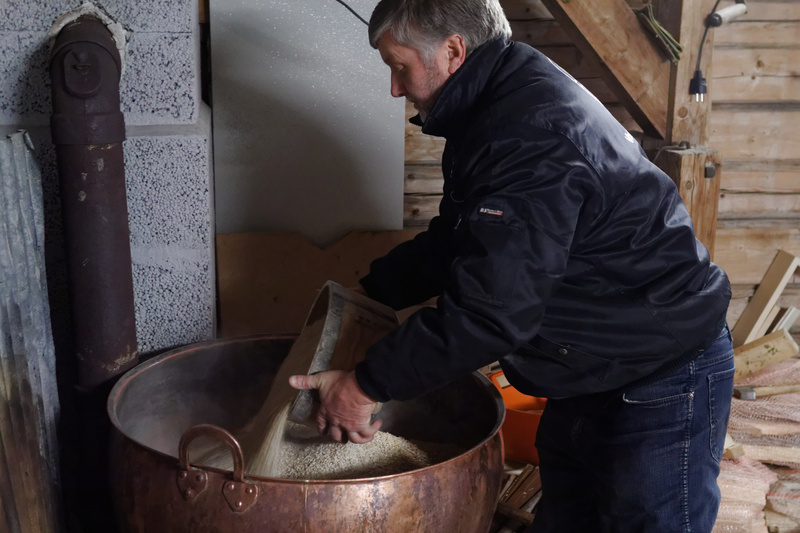
Sverre pouring the malts into the kettle. |
It may sound risky to leave the mash wet over night like this, but it was -10C outside, and ice cold in the brewhouse. The water was just a few degrees above freezing, and it wasn't going to get any warmer during the night. So there was no reason to fear lactic acid bacteria. But the pH of the mash still fell, and that probably gave Sverre's mash better efficiency the next day. Presumably farmhouse brewers figured out this trick ages ago.
This "cold mashing" and mashing in the kettle are both brewing methods that are completely unknown in western Norway, but which used to be very common in eastern Norway (and Sweden). The guys I visited in Telemark in 2015 did the same.
The next morning I got up early, chewed a couple slices of bread, and walked 20 meters to the brewhouse where Sverre and his friend Kolbjørn Sando were just getting started. The first step was to pour 60 liters of cold water onto the wet malts in the kettle, then start the fire underneath the kettle.
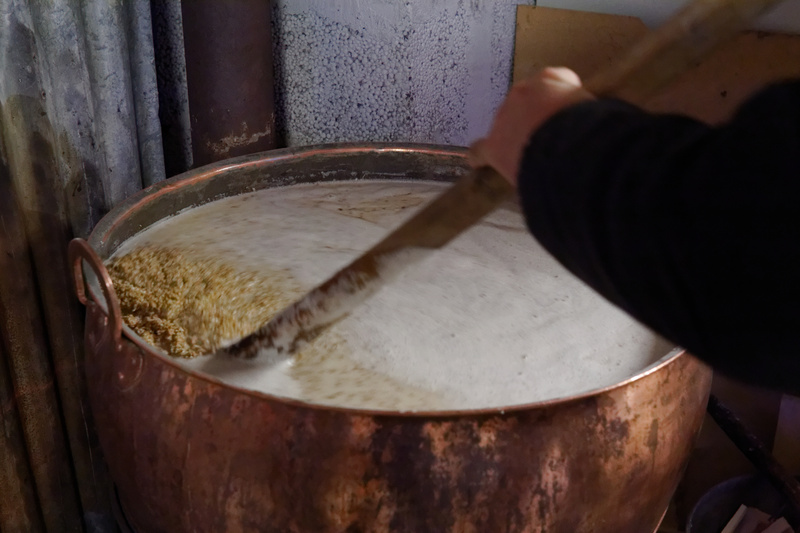
Sverre stirring the mash while it's being heated |
The idea is that the mash starts at something like 5C, then is gradually heated by the fire, and slowly goes through all the necessary mash temperatures. You could say it's like a stepless step-mash, although Sverre's mash is relatively fast. But he has a second phase later when the mash is in the lauter tun. The fire underneath was quite intense, so the guys had to keep stirring the mash all the time. Sverre said that if you stop stirring the mash will burn. If at any point you're left alone and you have to go to the toilet you'll just have to pee your pants, he said, because no way can you stop stirring.
Sverre heats the kettle with finely chopped wood, to make it easier to regulate the heat. He says in the old days the women used the same technique when baking flatbread, to avoid burning the bread.
Heating the mash takes a good while, so in the meantime they start preparing the lauter tun. Traditionally, this would have been shaped like a wooden barrel, with a tap in the side on the bottom. These wooden vessels are a bit of a pain to work with, so Sverre got a local to make him a lauter tun in stainless steel. Sverre drew it as a fairly exact replica of the old ones, complete with three legs and tap in the side. It's insulated inside the steel with the same material used in sleeping pads.
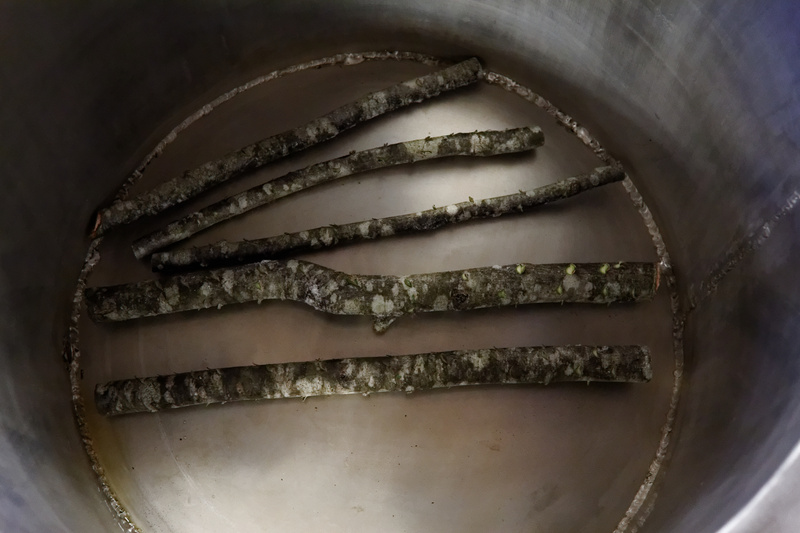
Alder sticks at the bottom of the lauter tun |
In the bottom of the tun they put sticks of alder wood. This was traditionally very common, although nobody seems to know why. Sverre and Kolbjørn cut marks in the bark to let the juice out. They claimed the alder wood has a preservative effect. On top of it they put a thick layer of juniper. "Not many berries this year," commented Kolbjørn. I asked them if that matters, and they were very clear that they don't care about the berries.
Sverre's juniper is unusual in one respect: it's alpine juniper, collected at 900-950 meters above sea level. Alpine juniper is a subspecies of common juniper that grows like a low, creeping shrub and has boat-shaped needles. Its internal chemistry is somewhat different from lowland juniper, so it's quite interesting that Sverre takes the trouble to collect the alpine variety.

Sverre laying juniper in the lauter tun bottom. |
Finally, a cloth bag went over the branches and was wrapped around the edge of the tun. The bag was made by Sverre's mother, Ågot, and both Sverre and Kolbjørn said this was traditional.
Eventually, after about two hours the mash started getting warm enough, hitting 62C. They didn't want it to go over 67C, because they've heard that if it does the whole thing turns to porridge and it will be impossible to lauter the wort. In old descriptions I've seen people worry about the same thing, but then it was boiling the mash that worried them.
The temperature was going up fast, and they weren't quite ready to transfer the mash yet, so they solved the problem by pouring half a bucket of water into the mash. That took the temperature from 67.5C down to 64.5, but it started increasing again almost immediately, so in the end they had to add the rest of the bucket, too.

Sverre ladling out the mash while Kolbjørn stirs. |
Finally, everything was ready, and Sverre started ladling the mash into an enameled washbasin and pouring it into the lauter tun. The brewhouse filled with the aroma of hot mash and juniper infusion. This confused me. They hadn't made juniper infusion, so why did I smell it? Had I gotten so used to brewing with juniper that the aroma of mash was enough to make me think of juniper? But then I remembered the juniper branches in the lauter tun. That's where the aroma was coming from, of course.
Once everything had been ladled over they put on the wooden lid and covered the lauter tun in blankets that they strapped down. Now the mash was left to sweeten for 2 and a half hours. That gave us time for a break and some lunch.
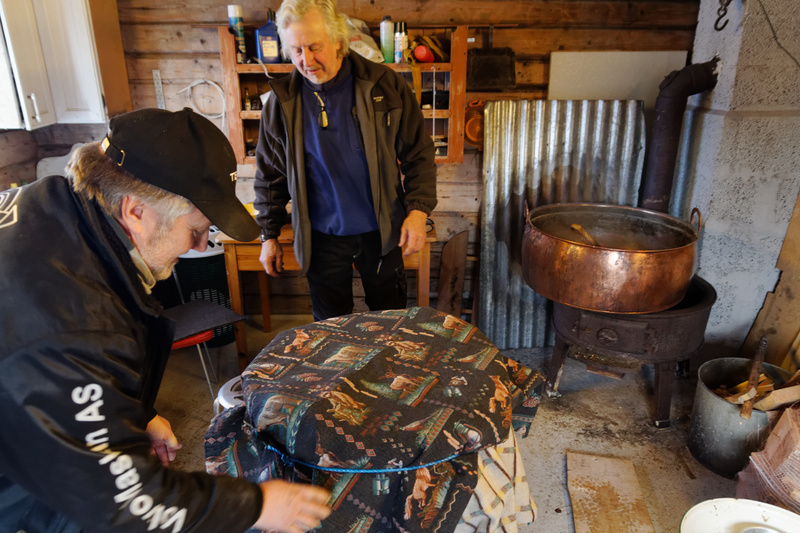
The mash being strapped down. |
Suddenly, Sverre came dragging juniper branches into the brewhouse and stuffed them into the kettle. It turned out that they did use juniper infusion, after all, but only for the lautering. Like many others, Sverre wants just the thin tips and avoids thicker trunks. They boiled the juniper and were very pleased with the dark brown colour of the infusion.
Now the time had come to actually run off the wort, move it into the kettle, and start the fire under it again. Sverre and Kolbjørn boiled the wort for 2-3 hours and evaporated off a good bit of water to concentrate the wort. They didn't boil very hard, though.

Ladling on juniper infusion for the sparging. |
Into the wort Sverre added six handfuls of hops. One for each settung of malt. The hops are European noble hops, although historically people used their own hops here. Sverre used to have a hop plant climbing up the wall of his house, but it died. He doesn't know why. In older times most of the farms here had their own hop gardens.
While the wort boiled, we headed into the house where Ågot, Sverre's mother, was preparing the yeast. Sverre said that even when his father brewed, his mother was the one that handled the yeast. Entering the kitchen I was astonished to see pieces of cloth with a thin, dry crust of darkish-brown yeast on them. I'd read about people storing yeast by drying it on cloth, but never actually seen it.

Gong dried on cloth. |
This is the "gong", the yeast that Sverre inherited from his father. Exactly where it came from before that he's not quite sure. He also shares it with Bjarne Halvorsgard, another local brewer. So the exact origin of the yeast is difficult to pinpoint, but it's definitely been in the village for a long time. Beyond that it was not at all clear what it was, except that it could ferment beer.
It turned out Ågot takes the harvested yeast and smears it on cloth, where it is dried. She has a box full of these cloth pieces with dried yeast on them. After they're dried she cuts them into suitable sizes for the next brews.
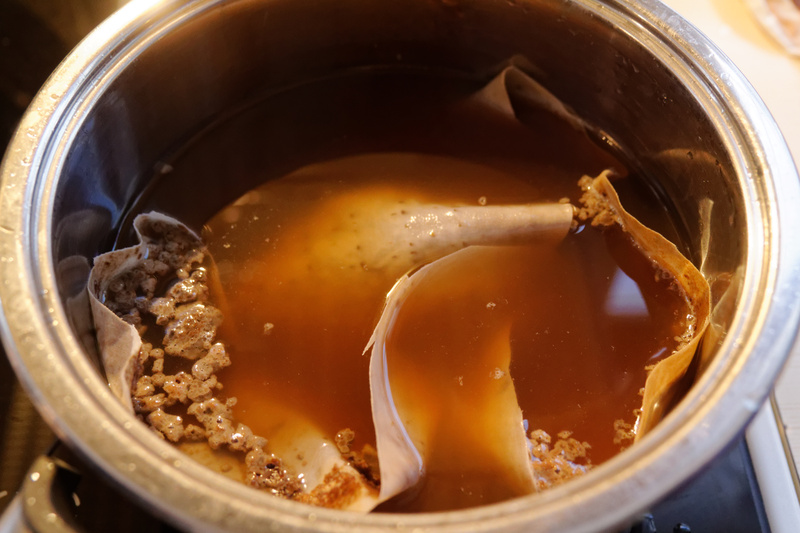
The yeast starter in a heated saucepan. |
For this brew she'd taken some wort and put it in a saucepan, then put a cloth with yeast into it. The pan sat on the stove with gentle heat turned on underneath. In between the pan and the stove was a trivet made of metal rings, to make sure the heat really was gentle. I measured the temperature of the starter, and it was 40C. While Sverre and Kolbjørn were brewing in the brewhouse, Ågot watched over the yeast starter in the kitchen.
Once the wort had finished boiling it was time to cool it. The wort was ladled into two large milk cans, and carried outside in the snow. To cool it we used snow shovels to cover the cans in snow. Because the snow nearest the can melts and leaves an empty space near the can, Sverre and Kolbjørn constantly kept packing on more snow. This approach was very effective. We managed to get the wort from boiling hot to 40C in about 15 minutes.
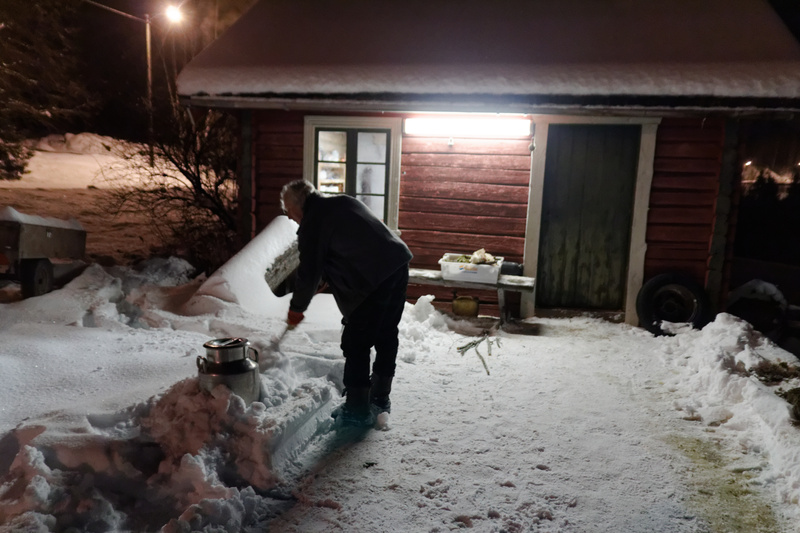
Kolbjørn packing snow onto the milk cans. |
In the end they got 45 liters of wort out of the 31 kilos of malts, for an OG of 1102. So clearly this beer was going to be strong, at maybe around 10%.
The milk cans were carried into the main house, and into a laundry room, where the big metal lauter tun was ready for its new role as fermentor. The contents were poured in, and the saucepan with the yeast starter poured in after them. Sverre strapped down the fermentor with blankets so it would keep warm, while his mother said pleadingly: "And no peeking before tomorrow!" It sounded like Sverre opens it up too often for her liking.
Sverre says that in the last few decades they used to pitch the yeast at 30C, but that in the old days they pitched higher. His father reduced the temperature, because he was worried that if they pitched too hot the beer would ferment too furiously, "turn," and go sour. They've had problems with the fermentation not starting sometimes, and Sverre thinks that may be because they pitched too cold. So he's now started pitching at 37C again, and he said they've had less problems with getting fermentations to start after he did that.
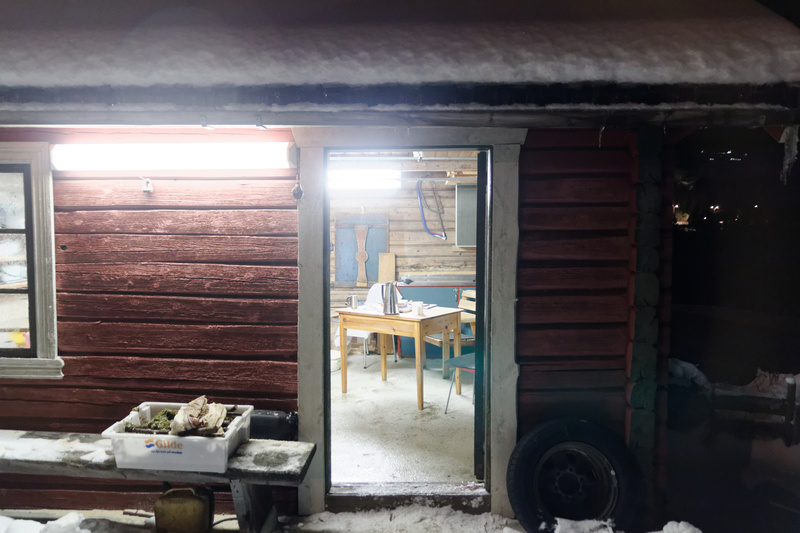
Brewhouse with spent juniper in a box outside. |
The next morning, before I left, the surface was covered in foam and everything seemed to be going swimmingly. So I got in the car and drove home. Three days later Sverre skimmed off the gong from the top of the fermentor, then transferred the beer to milk cans. After a couple of days in the cans he bottles the beer. When he bottled the beer he felt it was a bit too sweet still, but he bottled it anyway.
A few days before Christmas Sverre sent two bottles of the finished beer with a friend to Oslo, and I went to her flat and picked them up. Pouring the beer at home I found it was darkish red, with no real carbonation (as is typical).
Tasting it I was astonished to find that it was not just sweet, but very sweet, and kind of balanced by acidity. The flavour was decidedly strange, a mix of sweet malts, juniper, fruits, and an odd aroma kind of like tomato soup. I checked the sugar content and found it was 1.084, so the beer was just 2.4%.
Asking Sverre about it he said that this is how he likes it: he likes the sweet malt flavour and doesn't care so much about the alcohol. "If you want to get drunk you can have a shot of vodka. Or 10," he said. Although usually he ferments the beer to 3.5%, so it should have been a little less sweet and a little stronger.
In the old days, however, the beer in Ål probably was very strong. I need to get in touch with more of the brewers in the area to learn more. This could be a typical local beer, but I suspect it's probably not.
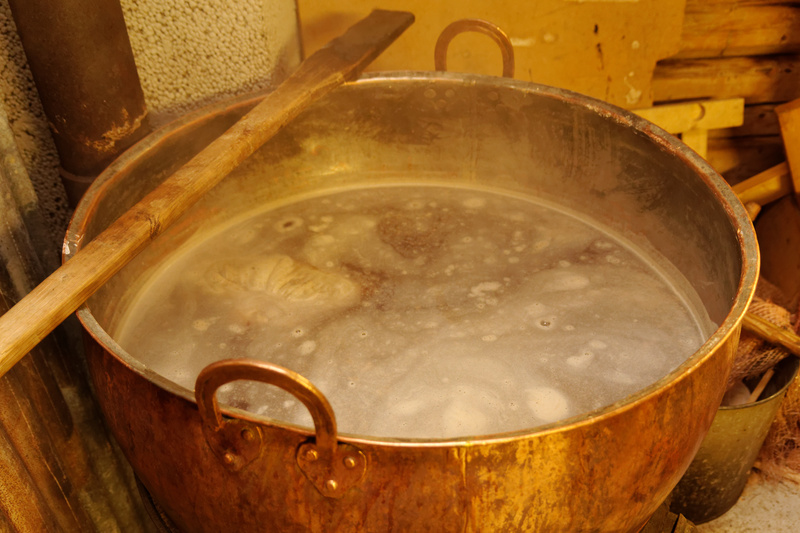
Wort boiling with hops in a cloth bag. |
Gong
I call the yeast gong, because that's what Sverre calls it. The most common word for yeast in eastern Norway was gong (although many also said "gjester", pronounced "yester"). Of course, that the yeast is called something other than kveik does not mean that it necessarily is something else.
The Farmhouse Yeast Registry lists three examples of gong: #26 Arnegard, #27 Krosshaug (Sverre's yeast), and #28 Halvorsgard. We've since figured out that #27 and #28 are really the same. #26 it has taken quite a lot of time to revive, but that one now seems to be alive as well, but we know much less about it.
In the two years since that visit Richard at Escarpment has had time to study the yeast. I can reveal two things they have learned. First, gong is not kveik. Second, it is closely related. Beyond that, work is still ongoing, and we'll know more when the full study comes out.
This is quite striking, because so far every single brewer in western Norway who has their own yeast has had yeast that belongs to the kveik family. And then our first samples of farmhouse yeast from the other side of the mountains turns out to be a different kind of yeast, but one that's related.
That suggests that perhaps kveik was always only a western Norwegian thing, and that eastern Norway had different yeast. Of course we need more samples to be sure. In 2019 farmhouse yeast did show up in Telemark, well south of Ål, and that may perhaps give us more information, but for now we have no results on those yeasts. Locally those are called "berm".
I hope we'll know a lot more about what yeasts were historically used in Norway before too long, but we need more work to get there.
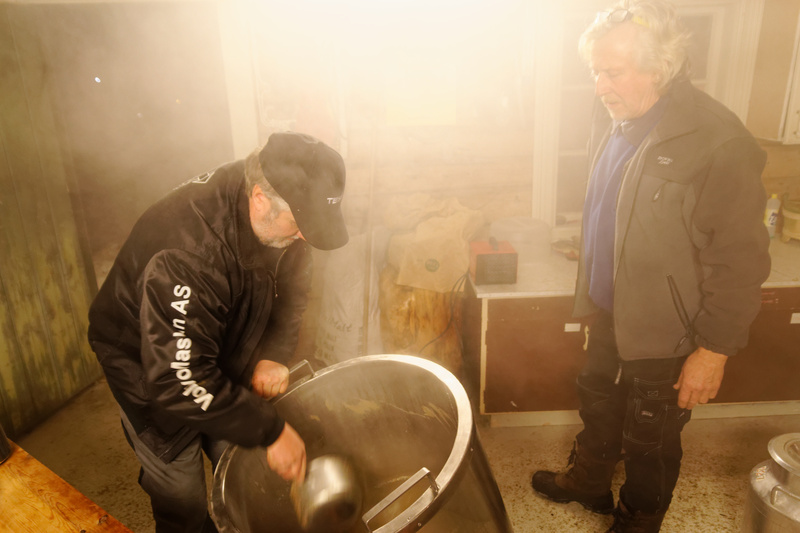
Removing the spent grain. |
Recipe
Ingredients for 45 liters of beer:
- 14.5kg pale malt
- 14.5kg pilsner malt
- 2kg caramel malt
- 6 handfuls of noble hops
- Alder branches
- Juniper branches
- Yeast (gong)
The evening before, put the malt in the kettle and pour on a few liters of cold water, then work that in. Ensure the mash stays cold until morning.
In the morning, add 60 liters of water to the mash, then start the fire underneath. Keep stirring until it hits 67C. Then transfer the mash to the lauter tun, and let it stand there about two hours. Run off the wort and boil it 2 hours with hops, boiling away some of the water.
Remove the hops and cool to 37C, then pitch the yeast. Ferment 3 days, then move to secondary for a couple of days before bottling.
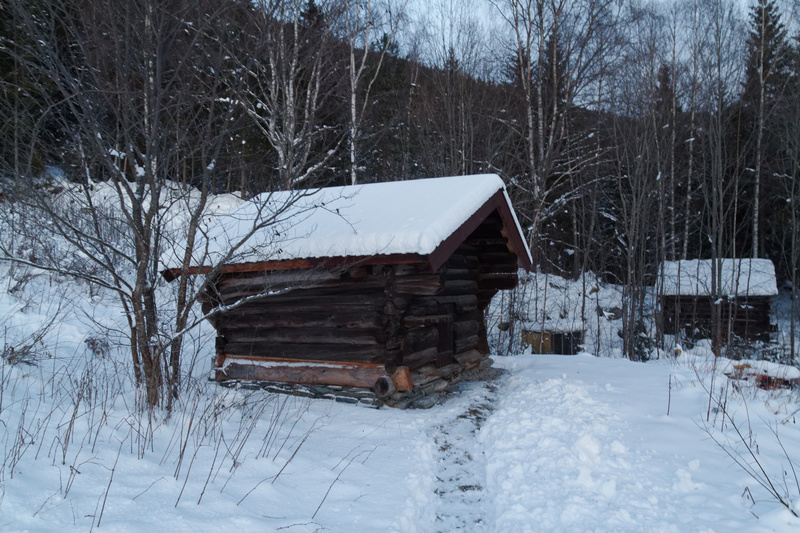
The old malt kiln (badstu) on the farm. |
Similar posts
Brewing with Olavi the champion
We drove along dirt roads through seemingly empty forest for half an hour, the dust curling lazily behind us
Read | 2021-05-22 13:26
Brewing a Norwegian farmhouse ale
When cousin Svein asked if I wanted to come to Sogndal to learn how to brew a traditional Norwegian farmhouse ale there was only one possible answer
Read | 2013-12-01 16:34
Analysis of farmhouse yeast (kveik)
The Norwegian University of Science and Technology (NTNU) in Trondheim started doing research and courses on brewer's yeast a little over a year ago
Read | 2016-09-06 16:30
Comments
George Newman - 2020-04-05 16:41:58
Hi Lars Marius, It never ceases to amaze me that there is such a rich and far reaching history relating to farmhouse brewing in Norway and how lucky the world brewing fraternity is for this story being re-discovered and re-told by yourself. Thank you
John - 2020-04-05 19:48:03
Lars, How on earth did he manage to bottle a very underattenuated Beer without it exploding? Is this yeast just that „weak“?
James - 2020-04-06 01:41:03
As others have observed on Twitter, that is a very low attenuation rate, particularly if the gong behaves like kveik (but really it's low for any yeast).
Re: the tomato soup flavor, could that be dimethyl sulfide (DMS)? With a boil that long I wouldn't think so, but everything about this beer is confusing to me.
Daming - 2020-04-06 03:18:11
Man great story and traditions. Here in Hong Kong we dream of that kind of cold as we are constantly (except for 2 or so months in our 'winter') fighting the heat! I too wonder about the under-attenuation - is it because the carb phase occurs in such cold?
Lars Marius Garshol - 2020-04-06 07:58:34
Guys, I don't know why the beer is so under-attenuated. It's possible that this yeast quite simply can't handle more alcohol. Or that it's so underpitched into this massively sweet wort that it can't ferment more. I don't know. I need to do more work on this, but haven't gotten that far yet.
David McQueen - 2020-04-06 08:16:08
Fascinating and thank you for recording these traditions so that they. An be preserved. Following last question how does the brew suddenly stop on bottling with so much sugar. With regular yeast those bottles would be hand grenades!
Ben M - 2020-04-06 19:19:21
Interesting that at least some people in Eastern Norway call yeast 'berm'. Here in England krausen used to be called 'barm' and it was transfered from brew to brew (as well as to raise bread). I'm sure the two are linguitically linked.
Nick - 2020-04-10 16:59:04
The gong, kviek and barm relationship is interesting. The farmhouse brewing vessels also appear interchangeable for beer, bread and cheese making. One set of vessels for wheat, barley and milk becoming three foods: Bread; Beer and Cheese. If at some stage copper was too expensive and wood the accessible option would it make sense for a farmstead to have just a single set of interchangeable wooden vessels for the several food making tasks? I wonder? I collected Kviek from my first brewing trial, froze it and then for fun pitched it into bread flour as a sourdough starter. Fed at 8AM and 8PM daily, the starter yielded a beautiful spice to fruit fragrance on top of the grain. It makes fragrant crumb and the crust comes out of the oven thin and crisp. I can't explain all this! Lars, can you please say more about Mr.Skrindo's wood fired kettle stove? Was it a purpose built manufactured item just for kettles or a DIY adaption from a "Pot Belly" stove base? Thanks for everything!
P.S. Do you suppose this is actually the first recipe and rule for making wholesome food: "One Ring to rule them all, One Ring to find them, One Ring to bring them all and in the darkness bind them. In the Land of Mordor where the Shadows lie.”
Lars Marius Garshol - 2020-04-11 08:48:17
@David: I don't really know how it fails to overcarbonate. Sorry!
@Ben: There are several places in the UK where farmhouse brewers called their yeast 'barm'. Similar words were used some places in Denmark and Sweden as well. And, yes, they are all definitely etymologically linked. Which is not so surprising: eastern England was once under Danish rule, just like Orkney was under Norwegian rule.
@Nick: There was some overlap in the vessels used for different purposes, but the patterns here are quite complicated. In Norway it was not unusual to have a set of brewing utensils that were only ever used for brewing, because brewing was a semi-holy act. Many places there was no wheat, and hence no baking, either. The lauter tun is a vessel that's unique to beer brewing, and the different forms of that can actually tell us quite a lot. (There's a little bit about that in the book.)
Copper did use to be too expensive for farmers to afford. That's a key point in the evolution of farmhouse brewing.
His stove is commercially made, to fit the kettle. Those stoves are actually not unusual.
Kate - 2020-07-12 07:05:31
This was a fascinating read. Thank you so much for sharing the history & I love your writing style!
Carl - 2020-08-23 22:16:03
Lars:
I really enjoy reading your stories. My family emigrated from Norway to the US in the 1890's. I have returned to the old country a few times. I did taste a Kveik in Bergan a couple years ago. I wrote to share an old brewing story from my family, from the village of Eidbo, near Sagesund and Tvedestrand down the West coast from Oslo. My uncle wrote a "family history", somewhat accurate; here is a digest of an early story:
Elling Frantsen passed away in 1848, and left a widow and six kids. The oldest son, Ole, was to take over full management of the farm, and made this agreement with his mother. He was to provide the following items annually for the rest of her life:
2 Specidollars 1 bismerpounds of salt pork
2 barrels of rye 1/2 bismerpound of dried codfish
2 barrels of barley to be 26 pounds of coffee
ground for baking bread 6 pounds of sugar
1/4 barrel of malt for beer 1 bushel of malt
1/4 barrel of whole wheat 1/2 pound of hops
4 pounds of rice 1 sheep for butchering
1/8 barrel of peas enough salt for daily needs
1 lispound of wheat flour milk from one cow
4 barrels of potatoes wool from one sheep
So apparently brewing is in my family history. I have been a homebrewer for over 30 years, and have traveled many places in search of the local beers.
Lars Marius Garshol - 2020-08-24 06:13:01
@Carl: Thank you!
This type of agreement was extremely common. Once the old people gave up the farm they were too old to farm, they no longer had any income, so this type of agreement was basically their pension. My old grandmother took over her farm in the 1960s by making a similar agreement. It was called 'living on "kår"'. "Kår" could be translated as conditions or terms.
And, since your family comes from Norway, there is brewing in your family history. Absolutely every farm in Norway south of the Arctic Circle has been brewing beer for many, many centuries.
From the agreement you can tell that this is a fairly well-off family, and not subsistence farmers like most people. That agreement has him providing several items that were imported, and so must be purchased with money: wheat, rice, coffee, and sugar.
Pedro - 2020-09-03 09:09:45
Great write up, very interesting. I wonder if the genetics of the gong yeast will be more similar to the mainland as there is one less barrier to go. Another interesting result would be if Kveik actually descended from Gong, from before brewing traditions crossed the mountains.